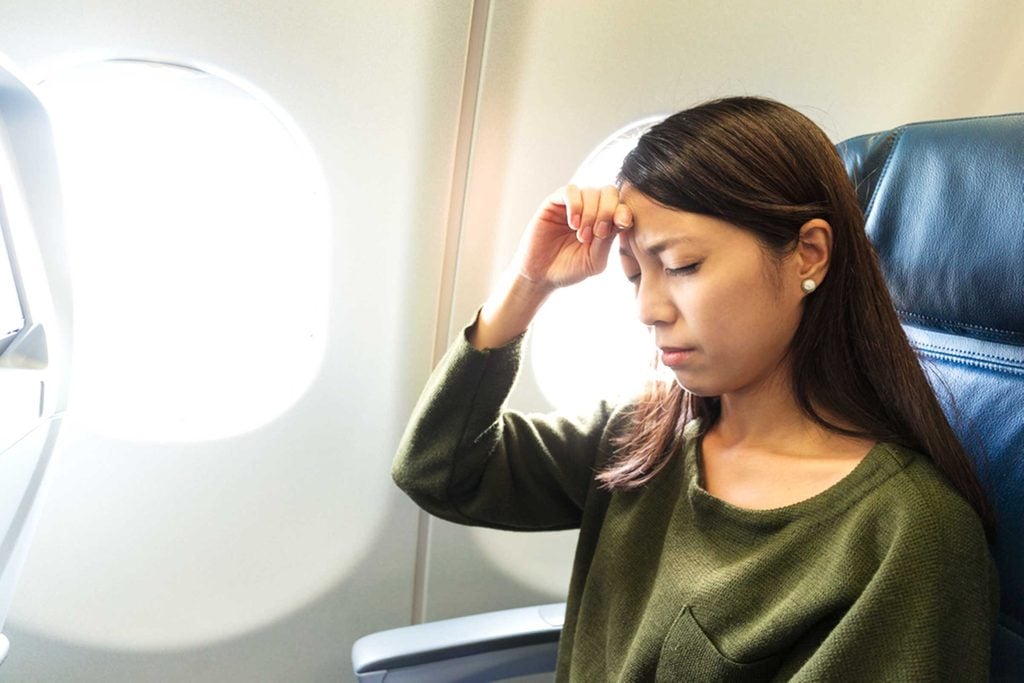Why You Get a Headache When You Fly—and How You Can Stop It
Updated: Jun. 19, 2020
No one wants to start their vacation with a headache.
 With the summer upon us, you’re probably dreaming of jetting off in search of sun, sea and sand. (You’ve read up on the best ways to protect your skin, right?) However, many people dread the first leg of a vacation because they suffer from headaches while flying. These can be caused by several factors, so it helps to identify what kind of headache you’re prone to developing and then taking steps to reduce the risk—starting with a headache that’s unique to flying:
With the summer upon us, you’re probably dreaming of jetting off in search of sun, sea and sand. (You’ve read up on the best ways to protect your skin, right?) However, many people dread the first leg of a vacation because they suffer from headaches while flying. These can be caused by several factors, so it helps to identify what kind of headache you’re prone to developing and then taking steps to reduce the risk—starting with a headache that’s unique to flying:
Airplane headache
This nasty beast unique to air travel triggers intense stabbing pain located on one side of the head. About one in 12 people suffer from airplane headaches, and experts believe that the condition is caused by changes in pressure during take-off, flying at altitude, and landing. This pressure affects the sinus cavities causing extreme pain.
A study published in the Journal of Headache and Pain has thrown further light on the cause of this debilitating condition and holds out the hope of an eventual cure. Scientists from Aalborg University, Denmark, discovered that those who suffer head pain when flying have elevated levels of two substances: the stress hormone cortisol, and prostaglandin E2 (PGE2).
“The major changes in cabin pressure at take-off and landing may cause tissue damage and inflammation in the sinuses. This releases the substance PGE2, which can make the blood vessels in the brain expand and thus cause head pain,” master’s student and study author Sebastian Bao Dinh Bui told Science Daily.
Now that the team has discovered what causes airplane headaches, they’re moving on to look for a cure.
Sebastian Bao Dinh Bui outlined his plans: “There has already been success with using the migraine medication triptans for airplane headache as these prevent the blood vessels in the brain from expanding. In my thesis I will measure the biological effects of triptans using saliva samples from passengers while they are traveling.”
But until then, the following steps will go a long way towards making your vacation flight a pleasure rather than a pain.
Minimize stress
Packing for your vacation, getting to the airport, and negotiating immigration and customs can turn the best vacation into a nightmare. So try to minimize the stress by planning well ahead, especially if you’re traveling with children or pets. Have all your travel documents easily to hand and leave home in plenty of time to reach the airport, allowing extra time for unexpected delays.
Once in the departure lounge, try to relax with a book or magazine, or watch a movie on your favorite device. If you’re stressed or nervous, techniques such as mindful meditation or controlled breathing may help.
Drink up
Water, that is: Another common cause of a headache when flying is dehydration. It’s easy to forget to hydrate when you’re frantically getting ready for your flight. Or you may limit your drinking so you don’t have to disturb other passengers to visit the bathroom mid-flight.
But the pressurized air in the cabin can make dehydration worse, so always carry plenty of water, and sip it little and often to stay well hydrated. Steer clear of salty or sugary snacks which will increase your thirst. And remember that tea, coffee and alcohol can also increase dehydration, so drink them in moderation alongside your water.
But no booze
Resist the temptation to over-indulge in alcohol to help you relax or to begin your vacation celebrations early. It will only give you a hangover later, and it’s no fun managing a pounding head and nausea at 30,000 feet. Save any alcoholic drinks to accompany your inflight meal.
Be prepared
Stress is a major trigger for migraine, so reducing your stress levels will help avoid a migraine during the flight. However, if the worst happens, be prepared by keeping your usual painkillers in your carry-on bag, so you can take them the moment you feel a migraine coming on. If light disturbs you during an attack, carry an eye mask, and ear plugs may also help if you need to sleep to ward off the pain.
